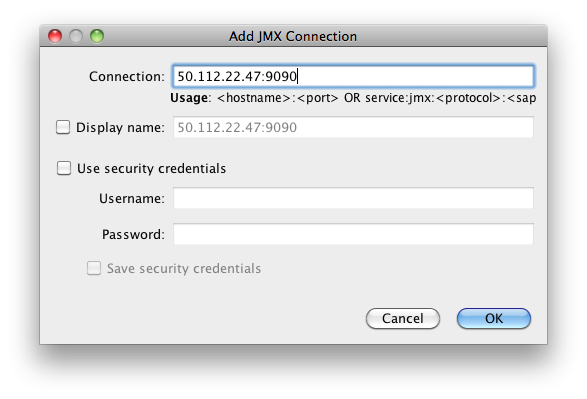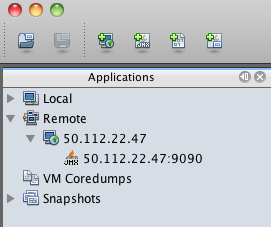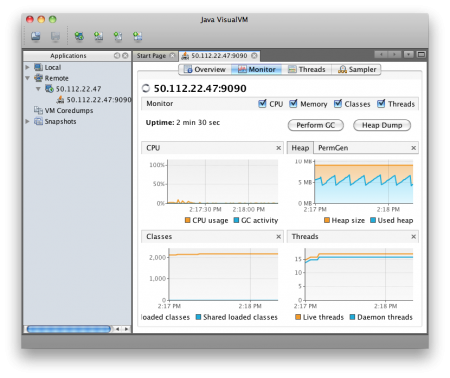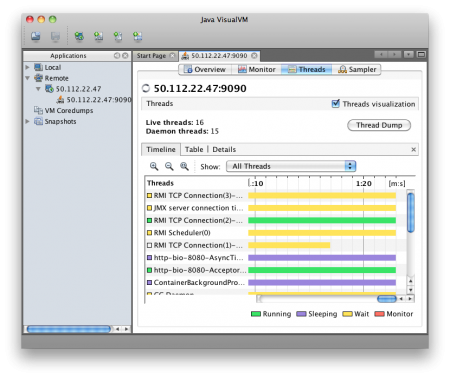connect VisualVM to Tomcat
https://blogs.oracle.com/jmxetc/
http://stackoverflow.com/questions/1051817/unable-to-connect-to-tomcat-using-visualvm
http://blog.markshead.com/1129/connecting-visual-vm-to-tomcat-7/
http://hackers.lookout.com/2014/06/profiling-remote-jvms/
You need to enable the management extensions to the Tomcat VM. Usually that means passing in something like these:
-Dcom.sun.management.jmxremote.port=8086
-Dcom.sun.management.jmxremote.ssl=false
-Dcom.sun.management.jmxremote.authenticate=false
Of course, if you do it the above way make sure your Tomcat isn't visible on the Internet or the port is firewalled from remote access or take similar security measures to avoid being port scanned and compromised. Otherwise use the authentication options.
http://blog.markshead.com/1129/connecting-visual-vm-to-tomcat-7/
Connecting Visual VM to Tomcat 7
by Mark Shead on February 5, 2012
Connecting Visual VM to a remote instance of Tomcat 7 is surprisingly easy. All you have to do is add some options to JAVA_OPTS turning on JMX, specifying how you want to handle security and setting the hostname. While it is easy to get it up and running, there are quite a few steps to go through if you want to make it work with authentication and behind a firewall.
My goal with this post is to walk through the basics of getting it running and then modifying the installation to support common configuration needs.
Here are instructions for how to set it up using Ubuntu 11.10:
First lets install Tomcat 7 if you don’t have it.
sudo apt-get update sudo apt-get upgrade sudo apt-get install tomcat7
Now we need to set the JAVA_OPTS. We will do that by creating a setenv.sh file in /usr/share/tomcat7/bin/ and putting the options in there. setenv.sh gets called before Tomcat starts to set any environmental variables you may want.
export JAVA_OPTS="-Dcom.sun.management.jmxremote=true \
-Dcom.sun.management.jmxremote.port=9090 \
-Dcom.sun.management.jmxremote.ssl=false \
-Dcom.sun.management.jmxremote.authenticate=false \
-Djava.rmi.server.hostname=50.112.22.47"
Line 1 enables jmxremote. Line 2 specifies the port. Line 3 says that we don’t need to use ssl. Line 4 says to leave it wide open and not use any type of authentication. Line 5 specifies the ip address of the server where you are running Tomcat. (Don’t use my ip address of 50.112.22.47, substitute your own.) This is left out of many instructions on the web, so it might work in some circumstances without it, but I wasn’t able to connect with VisualVM unless this configuration points to itself.
I believe this has to do with the fact that JMX is going to open another connection on a random port (discussed below). If you don’t tell it what its hostname (or ip) is, JMX doesn’t know how to tell the client how to connect back to that other port.
Now open VisualVM. On OS X you just run:
jvisualvm
Add the connection by clicking on File > Add JMX Connection… and fill out the dialog box as shown (but using the ip address of your server). 
Once you add it, you should see the server in the list on the left hand side. Double click on the JMX connection to the server. (The JMX connection has a JMX icon and should show port 9090.) 
You should then be able to view the following screens of information showing what is going on inside of Tomcat. 

Firewall
One problem people run into in getting this to work is that they open port 9090 (or whatever they have specified) and VisualVM is unable to connect. This is because JMX appears to accept connections port 9090, but then opens at least one other random port and instructs the client to connect to this port as well.
If we run
sudo netstat -ntlp
We should see something like this:
ubuntu@ip-10-252-22-93:~$ sudo netstat -ntlp Active Internet connections (only servers) Proto Recv-Q Send-Q Local Address Foreign Address State PID/Program name tcp 0 0 0.0.0.0:22 0.0.0.0:* LISTEN 494/sshd tcp6 0 0 :::8080 :::* LISTEN 2650/java tcp6 0 0 :::36851 :::* LISTEN 2650/java tcp6 0 0 :::22 :::* LISTEN 494/sshd tcp6 0 0 :::35543 :::* LISTEN 2650/java tcp6 0 0 :::9090 :::* LISTEN 2650/java
Line 4 shows ssh running on port 22. 5 is where Tomcat is serving HTTP. 9 shows the JMX connection. However 6 & 8 appear to be part of the JMX process. If you have firewall that is blocking access to these ports, VisualVM won’t be able to connect. You can’t just add those specific ports because they are random and can change every time Tomcat is restarted. So you have to leave your machine wide open to connect or use the Listener that will be explained a few sections below.
Authentication
Now lets look at how to secure the connection a bit and require a username and password. We can change the settings we put into setenv.sh to tell it to require authentication by changing false to true.
export JAVA_OPTS="-Dcom.sun.management.jmxremote=true \
-Dcom.sun.management.jmxremote.port=9090 \
-Dcom.sun.management.jmxremote.ssl=false \
-Dcom.sun.management.jmxremote.authenticate=true \
-Djava.rmi.server.hostname=50.112.22.47"
By default this should look for two files. One is called jmxremote.access and the other is jmxremote.password. It will probably look for the files in /usr/lib/jvm/java-6-openjdk/jre/lib/management/ but this may be different depending on which JDK you have installed and in some cases it will look for the files in the CATALINA_HOME directory.
We need to specify where the files should be found with the following options. Here we specify the files will be in the tomcat7/conf directories. So now our /usr/share/tomcat7/setenv.sh file should look like:
export JAVA_OPTS="-Dcom.sun.management.jmxremote=true \ -Dcom.sun.management.jmxremote.port=9090 \ -Dcom.sun.management.jmxremote.ssl=false \ -Dcom.sun.management.jmxremote.authenticate=true \ -Djava.rmi.server.hostname=50.112.22.47 \ -Dcom.sun.management.jmxremote.password.file=/var/lib/tomcat7/conf/jmxremote.password \ -Dcom.sun.management.jmxremote.access.file=/var/lib/tomcat7/conf/jmxremote.access"
jmxremote.password should look something like:
jmxadmin mysecretpassword
and jmxremote.access should have something like:
jmxadmin readwrite
Our user is jmxadmin, but could be any username. jmxremote.password tells what password is assigned to each user and jmxremote.access tells what access rights each user has. For a user to have access, they need to have an entry in both files.
Now if you try to run this setup, you will probably see something like this error in your catalina.out file:
Error: Password file read access must be restricted: /var/lib/tomcat7/conf/jmxremote.password
To fix this we need to make sure that both files are owned by the tomcat7 user:
sudo chown tomcat7:tomcat7 /var/lib/tomcat7/conf/jmxremote.*
Then we need to make sure that the tomcat7 user is the only user who has read access.
sudo chmod 0600 /var/lib/tomcat7/conf/jmxremote.*
Now you should be able to create a new connection to the server as before, but this time specifying the username and password you wish to use to connect. VisualVM wouldn’t let me just modify an existing JMX connection, so I had to create a new one rather than just adding the username and password to the existing connection.
Controlling the Ports
The only remaining inconvenience is the fact that JMX is going to choose a random port. If you aren’t dealing with a firewall this might not be a big deal, but if you are dealing with a remote server in a data center or in the cloud, it becomes more problematic. We need some way to tell Tomcat to bind the other JMX ports to a specific port number rather than choosing something at random.
We can do this by adding a listener to the /var/lib/tomcat7/conf/server.xml file like this:
<Listener className="org.apache.catalina.mbeans.JmxRemoteLifecycleListener" rmiRegistryPortPlatform="9090" rmiServerPortPlatform="9091" />
Just put it below the other Listeners in server.xml. Notice the rmiRegistryPortPlatform is the 9090 that we previously specified in setenv.sh. The rmiServerPortPlatform allows us to bind the process to 9091 instead of a random port number.
Note: You can now remove the line that specifies port 9090 in setenv.sh.
In addition to adding the Listener we need to put the jar in /usr/share/tomcat7/lib/. The jar we are looking for is called catalina-jmx-remote.jar.
To locate this jar, first determine what version of Tomcat you are using by running the version script which will give us the output as shown.
ubuntu@ip-10-252-22-93:$ /usr/share/tomcat7/bin/version.sh Using CATALINA_BASE: /usr/share/tomcat7 Using CATALINA_HOME: /usr/share/tomcat7 Using CATALINA_TMPDIR: /usr/share/tomcat7/temp Using JRE_HOME: /usr Using CLASSPATH: /usr/share/tomcat7/bin/bootstrap.jar:/usr/share/tomcat7/bin/tomcat-juli.jar Server version: Apache Tomcat/7.0.21 Server built: Sep 8 2011 01:23:08 Server number: ...0 OS Name: Linux OS Version: 3.0.0-14-virtual Architecture: amd64 JVM Version: 1.6.0_23-b23 JVM Vendor: Sun Microsystems Inc.
In our case we are using Tomcat/7.0.21, so we want to go to http://archive.apache.org/dist/tomcat/tomcat-7/v7.0.21/bin/extras/. You can substitute your own version number in the URL to find the file.
Once the file is in /usr/share/tomcat7/lib/, restart your tomcat server and create a new JMX connection as specified above using VisualVM. You should now have a server that requires authenticated access for JMX and where
connect VisualVM to Tomcat的更多相关文章
- 使用VisualVM分析tomcat运行状况(1)
VisualVM是一款java程序性能分析与调优工具,而且还是jdk中自带的工具之一. tomcat也是一个java程序,自然也可以用它来进行监控.不过这里还是会有些问题,tomcat有两种常用的期待 ...
- visualvm监控tomcat
https://my.oschina.net/weidedong/blog/787203
- Windows平台下,Java性能分析工具VisualVM的Tomcat8的配置
VisualVM在JDK6版本及以上已经自带这个应用. 位置:C:\Program Files (x86)\Java\jdk1.8.0_60\bin\jvisualvm.exe 在Windows环 ...
- JMX configuration for Tomcat
Window下执行步骤: D:\apache-tomcat-7.0.57\bin\catalina.bat set CATALINA_OPTS=-Dcom.sun.management.jmxremo ...
- Tomcat翻译--The Host Container
原文:http://tomcat.apache.org/tomcat-7.0-doc/config/host.html Introduction(介绍) The Host element repres ...
- jmeter对tomcat性能测试
主要对tomcat的参数做一些记录(jmeter和tomcat在同一个计算机,可能引起测试误差) 我的计算机配置 4核8线程 8G内存 案例一 tomcat JVM 1.8G堆内存,无数据库操 ...
- tomcat 1.2 负载均衡
实验效果:访问同一个ip或域名,轮询显示两个不同的tomcat界面, nginx服务器ip:192.168.213.4 tomcat服务器ip:192.168.213.3 实验环境:两台服 ...
- 记一次Web服务的性能调优
前言 一个项目在经历开发.测试.上线后,当时的用户规模还比较小,所以刚刚上线的项目一般会表现稳定.但是随着时间的推移,用户数量的增加,qps的增加等因素会造成项目慢慢表现出网页半天无响应的状况.在之前 ...
- Linux ---> 监控JVM工具
Linux ---> 监控JVM工具shkingshking 发布时间: 2013/10/10 01:27 阅读: 2642 收藏: 26 点赞: 1 评论: 0 JDK内置工具使用 jps(J ...
随机推荐
- CAD字体显示问号的解决办法
CAD字体显示问号的解决办法1.选中问号的文字,ctrl+1查看下文字样式,以standard为例.2.运行st命令,设置standard样式的字体名为windows自带的ttf字体,例如宋体或者仿宋 ...
- h.Connector的SSL属性实现
前面分析了Connector的配置,第一步,Digester已经将上述的属性设置到Connector和xxxEndpoint中了. 下面对于一些核心属性,看看Tomcat是如何使用的: 1.SSLEn ...
- rpc选择标准
衡量RPC好用与否的几条标准: 真的像本地函数一样调用 使用简单,用户只需要关注业务即可 灵活,RPC调用的序列化方式可以自由定制,比如支持json,支持msgpack等方式 http://www.o ...
- 高版本正方教务系统上传后缀过滤不严导致能直接上传Webshell
在旧版本中有一个利用插件上传文件的漏洞,但是在新版本中已经没有了这个插件.这个漏洞是由于过滤不严造成的,可以直接上传Webshell进行提权,由于代码在DLL中,全国大部分高校均有此漏洞,影响范围很大 ...
- 读《程序员的SQL金典》[4]--SQL调优
一.SQL注入 如果程序中采用sql拼接的方式书写代码,那么很可能存在SQL注入漏洞.避免的方式有两种: 1. 对于用户输入过滤敏感字母: 2. 参数化SQL(推荐). 二.索引 ①索引分类 聚簇索引 ...
- 读《程序员的SQL金典》[2]--函数
一.数学函数 1.RAND SELECT RAND () ---0.302870228294199 取0-1之间的随机小数. 2.小数取整 CEILINT(data)舍掉小数部分并向上取整. FLOO ...
- Octopus系列之UploadValues异步上载
不多说了直接上代码 public void ProcessRequest(HttpContext context) { context.Response.ContentType = "tex ...
- iOS开发Swift篇—(四)运算符
iOS开发Swift篇—(四)运算符 一.运算符 1.Swift所支持的部分运算符有以下一些 赋值运算符:= 复合赋值运算符:+=.-= 算术运算符:+.-.*./ 求余运算符:% 自增.自减运算符: ...
- JavaWeb chapeter 5 Web应用程序状态管理
1. HTTP协议使用的是无状态连接,对容器而言,每一个请求都来自于一个新的客户. 2. html表单隐藏字段:对用户在网站上的访问进行会话跟踪.为服务器端程序提供预定义的输入.存储动态产生的页面上 ...
- sourceTree 更新svn提示can't locate SVN/Core.pm
装了sourceTree一直没有怎么用,今天试着用用,居然报错 can't locate SVN/Core.pm 详细报错如下: Can't locate SVN/Core.pm in @INC (y ...
